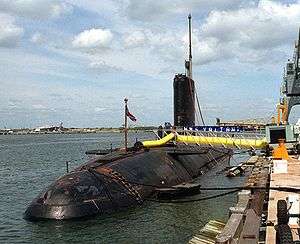Rolls-Royce PWR
The Rolls-Royce pressurised water reactor (PWR) series has powered British nuclear submarines since the Valiant class, commissioned in 1966. The first British nuclear submarine, HMS Dreadnought, was powered by a Westinghouse S5W reactor.
Nuclear reactor designs, operating methods and performance standards are highly classified. Details of this type regarding the reactors are not available.
PWR1

The first British naval reactor, the PWR1, utilising a core and reactor assembly of purely British design, went critical in 1965, four years later than planned.[1] Technology transfers under the 1958 US-UK Mutual Defence Agreement eventually made Rolls-Royce entirely self-sufficient in reactor design in exchange for a "considerable amount" of information regarding submarine design and quietening techniques being passed on to the United States.[2]
Rolls Royce and Associates at Derby is the centre for design and manufacture of the UK's submarine reactors. The Ministry of Defence's Vulcan Naval Reactor Test Establishment, at Dounreay, tested each reactor core design prior to its installation in nuclear submarines.
PWR1 submarines
- Prototype
- Vulcan Naval Reactor Test Establishment, Dounreay
- Core A
- Core B
- Core Z
PWR2
PWR2 is the latest nuclear reactor designed to power the Royal Navy's submarines. The PWR2 was developed for the Vanguard-class Trident missile submarines and is a development of the PWR1. The first PWR2 reactor was completed in 1985 with testing beginning in August 1987 at the Vulcan Naval Reactor Test Establishment.
The latest design of the PWR2 is the "Core H", which removes the need for refuelling, allowing a submarine to avoid two reactor refits in its service life. HMS Vanguard will be fitted with the new core during its refit, followed by her three sister boats. The Astute-class submarines will have this full-life core installed. As they were developed for SSBNs, the reactors are considerably larger than those of current British fleet submarines. The diameter of Astute-class hulls have therefore been increased to accommodate the PWR2.
A safety assessment of the PWR2 design by the Defence Nuclear Safety Regulator in November 2009, was released under a Freedom of Information request in March 2011.[3] The regulator identified two major areas where UK practice fell significantly short of comparable good practice, loss-of-coolant accident and control of submarine depth following emergency reactor shutdown.[4][5] The regulator concluded that PWR2 was "potentially vulnerable to a structural failure of the primary circuit", which was a failure mode with significant safety hazards to crew and the public.[6]
In January 2012 radiation was detected in the PWR2 test reactor's coolant water, caused by a microscopic breach in fuel cladding. This discovery led to HMS Vanguard being scheduled to be refueled early and contingency measures being applied to other Vanguard and Astute-class submarines, at a cost of £270 million. This was not revealed to the public until 2014.[7][8]
PWR2 submarines
PWR3
Three propulsion options were considered for the successor to the UK Trident system: PWR2, PWR2b (a PWR2 derivative with improved performance), and PWR3.[9] PWR3 is a new system based on a US design but using UK reactor technology.[10] All options would cost roughly the same but PWR3 is a simpler and safer design with a longer life and lower maintenance requirements than the PWR2 variants.[9]
In March 2011 Defence Secretary Liam Fox indicated PWR3 was the preferred option "because those reactors give us a better safety outlook"[10][11] and two months later the Ministry of Defence announced that PWR3 had been selected for Successor at a cost of about £3 billion.[6][10][12] PWR3 had a whole life cost of about £50m/boat more than PWR2 designs over a 25-year life, but its lower maintenance costs makes it cheaper over the longer service life than is possible with the PWR2 design.[9]
A confusing press release suggested that the seventh Astute-class submarine, HMS Agincourt, would have the PWR3 reactor[13] but in October 2012 it was confirmed that she would have a PWR2 like the rest of the Astute class.[14]
PWR3 submarines
- Dreadnought-class SSBN
- HMS Dreadnought (under construction)
- HMS Valiant (on order)
- HMS Warspite (on order)
- HMS King George VI (on order)
References
- Daniels, R.J (2004). The End Of An Era: The Memoirs Of a Naval Constructor. Periscope Publishing. pp. 135–136, 153. ISBN 1-904381-18-9. Retrieved 25 April 2017.
- p.529, Conway's All The World's Fighting Ships, US Naval Institute Press, Annapolis, 1996, ISBN 1-55750-132-7
- Rob Edwards (10 March 2011). "Flaws in nuclear submarine reactors could be fatal, secret report warns". The Guardian. Retrieved 28 March 2011.
- "Annex B: Successor SSBN - Safety Regulator's advice on the selection of the propulsion plant in support of the future deterrent (4 November 2009)" (PDF), Successor Submaring Project - Update, Ministry of Defence, 24 November 2009, p. 21, EC-14-02-02-01-14 / Annex B: DNSR/22/11/2, retrieved 28 March 2011
- Joseph Watts (11 March 2011). "Expert warned MoD on safety of Rolls-Royce nuclear sub reactors". Derby Telegraph. Archived from the original on 18 September 2012. Retrieved 28 March 2011.
- "PWR3 Reactor chosen for Trident". defencemanagement.com. 18 May 2011. Archived from the original on 22 July 2011.
- "Nuclear submarine to get new core after test reactor problem". BBC. 6 March 2014. Retrieved 8 March 2014.
- David Maddox (8 March 2014). "MoD accused of Dounreay radiation leak cover-up". The Scotsman. Retrieved 8 March 2014.
- "The United Kingdom's Future Nuclear Deterrent: The Submarine Initial Gate Parliamentary Report" (PDF). Ministry of Defence. May 2011. p. 5. Retrieved 12 October 2013.
- "Fox wants new reactors for Trident". defencemanagement.com. 15 March 2011. Archived from the original on 10 March 2012.
- Severin Carrell (23 March 2011). "Navy to axe 'Fukushima type' nuclear reactors from submarines". The Guardian. Retrieved 28 March 2011.
- "CSA: Safety paramount for RN nuclear submarine reactors". Defence News. Ministry of Defence. 9 June 2011. Retrieved 17 June 2011.
- "Royal Navy submarine contract awarded". UK Ministry of Defence. 18 June 2012. Retrieved 12 October 2013.
- "House of Commons - Written Answers Column 311W". Hansard. UK Parliament. 17 October 2012. Retrieved 12 October 2013.